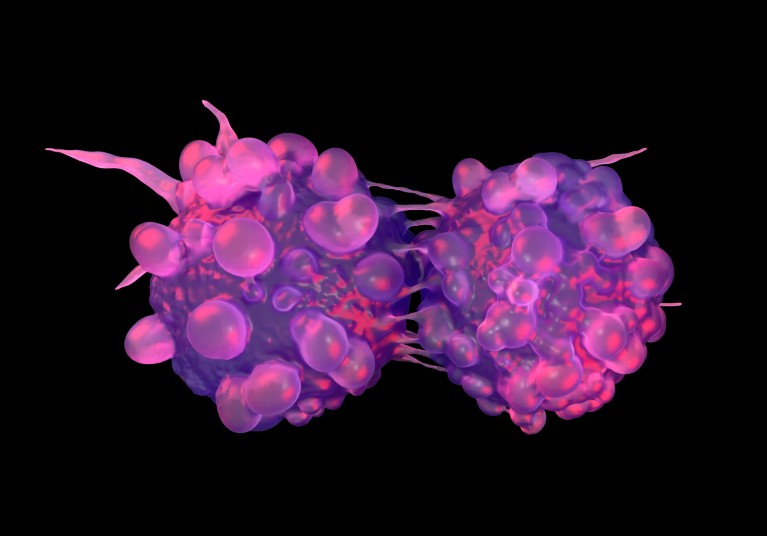
Janssen scientists are investigating interception methods for bladder cancer (pictured), colorectal cancer, and multiple myeloma.Credit: Science Artwork/Science Photo Library/Getty Images
Cancer remains the world’s second leading cause of death and the top killer in some high-income countries. Scientists at the Janssen Pharmaceutical Companies of Johnson & Johnson want to intercept cancerous tissue before it becomes a serious threat.
While there have been significant advances in treating advanced malignancy, even these new treatments fail to stop certain cancers after they grow and spread. The five-year survival rates for metastasized bladder and colorectal cancer, for example, are 5 and 15%, respectively. In addition to working to fight off mature cancers, especially ones already spreading in a patient, Peter Lebowitz —global oncology head of research and development at Janssen Research & Development, LLC — envisions a different approach: intervene before the cells become malignant. “Treat it before we would even call it cancer,” he says.
Requirements for interception
To create an interception method for a specific cancer, scientists study what causes the carcinogenic process to start, and what drives the progression from premalignancy to malignancy. Then, they develop methods to find those premalignant cells and treat them before they turn into cancer.
Currently, Janssen scientists focus on interception in three cancers: bladder, colorectal and multiple myeloma, a type of blood cancer. “In these three cancers,” Lebowitz says, “we have an understanding of the biology of the premalignancy, we know how to detect it and we have potential ways to intervene.”
With colorectal cancer, for example, scientists can identify premalignancy, such as polyps with a colonoscopy or with molecular markers in the stool. Then, the premalignant cells can potentially be treated with targeted and localized therapeutic approaches.
In addition to these three kinds of cancer, a team from The Lung Cancer Initiative at Johnson & Johnson headed by Avrum Spira, is developing approaches for lung cancer interception in partnership with Janssen scientists.
Identifying the indicators
To make any cancer interception work, early detection of carcinogenesis is critically important. While imaging and pathology are the standard methods, molecular markers will likely be needed for earlier detection. These markers could be bits of DNA circulating in a person’s blood or even evidence of biochemical changes to DNA, such as methylation. “More and more, it’s about our ability to survey for indicators of genetic alterations in tumours,” Lebowitz says.
It takes more than detecting signals, though, because clinicians need to interpret the information. “As time goes on, we’ll have more molecular markers to tell us about a person’s risk,” Lebowitz explains. “We’ll end up having multiple samples that need to be collected: blood, stool, urine and so on.” Data on molecular markers from all of those samples will be combined to determine if a patient requires some form of interception.
Developing the treatments
At first, cancer interception will use some existing drugs for treating cancer, just applied at an earlier stage. Other drugs will be created explicitly for interception. “To develop drugs that can selectively go after the premalignancy, we need to accomplish two things: localized exposure to the area where the premalignancy happens, and develop highly selective drugs,” Lebowitz said. “We’re working on both.”
The cancer-interception treatments should be specific for two main reasons: first, such treatments focus on very defined targets; and second, the treatments could be used in people who are otherwise healthy. So, the treatments should hit the premalignant cells or factors that contribute to their progression to malignancy, but not have an impact on anything else.
With colorectal cancer, for instance, Lebowitz says, “We know that the microbiome contributes.” In this case, bacterial treatment could be limited to the colon. Plus, he notes that some bacteria produce toxins that trigger the start of colorectal cancer. “So, we could target those bacteria or the toxins to reduce the risk of disease,” he says, but with no side-effects, because a patient’s own cells wouldn’t be targeted.
If using a pill to treat premalignant colorectal cells, other advances may be used in developing a new drug. Traditionally, a pill is designed to be absorbed quickly from the gastrointestinal tract and circulate in the blood for hours. “Instead, we want a pill that stays in the gut all the way through the gastrointestinal tract, so it can act on the colon to do what is needed to eliminate premalignant lesions,” Lebowitz says. “Then, as we understand that chemistry better, we can target the premalignant lesions without systemic issues.”
Building breadth
With so many steps — detection technology, developing new drugs and delivery mechanisms — collaboration is essential in creating effective approaches to cancer interception. “We need really good companies making new diagnostics, companies working in new areas like the microbiome, and others working on new ways to deliver drugs,” Lebowitz says.
“Interception is going to be the future of cancer research,” Lebowitz says. “We’ll be moving earlier and earlier on treatments, and it will change the way that we think about this disease.”


